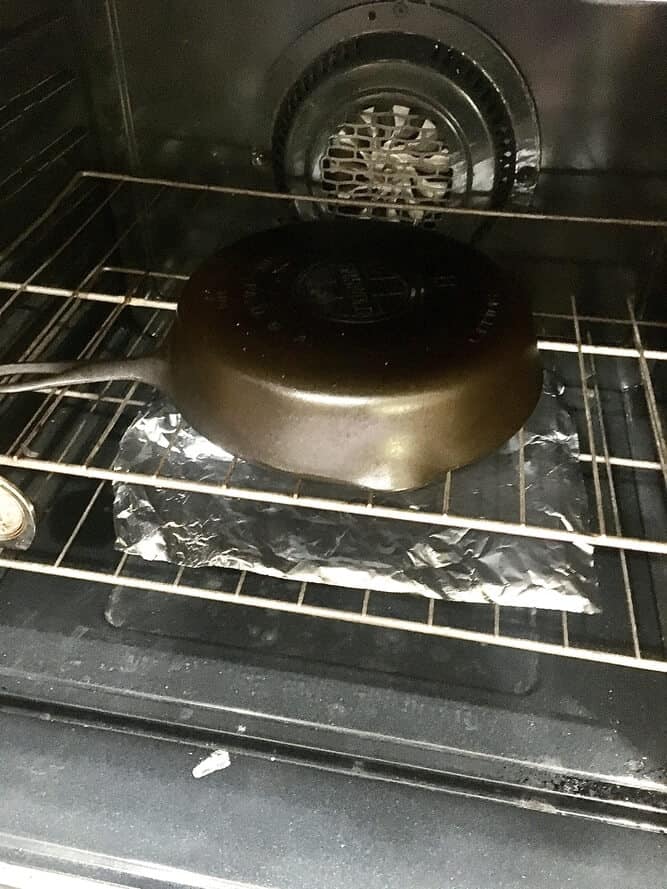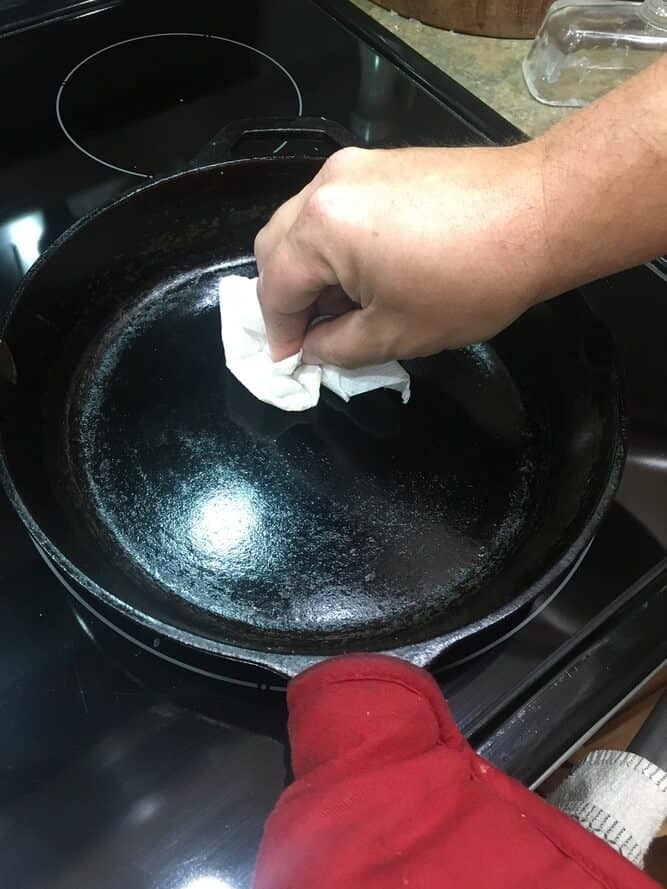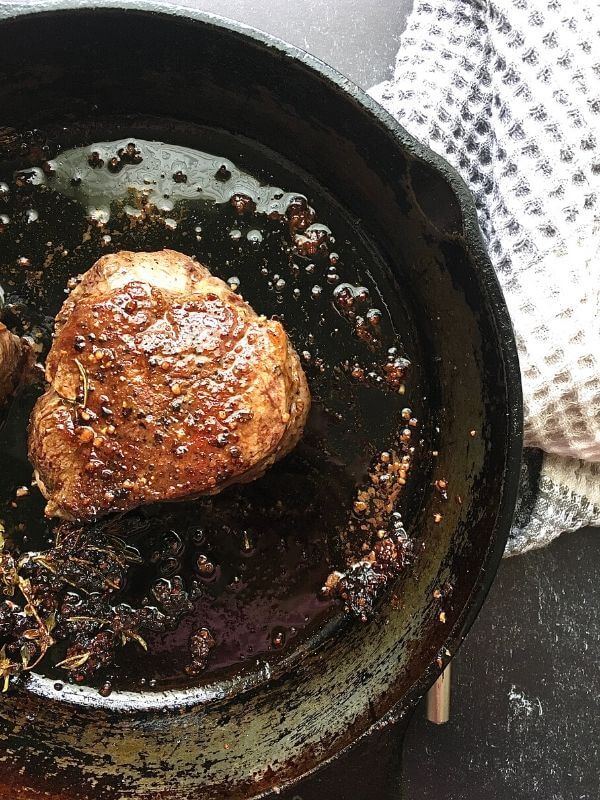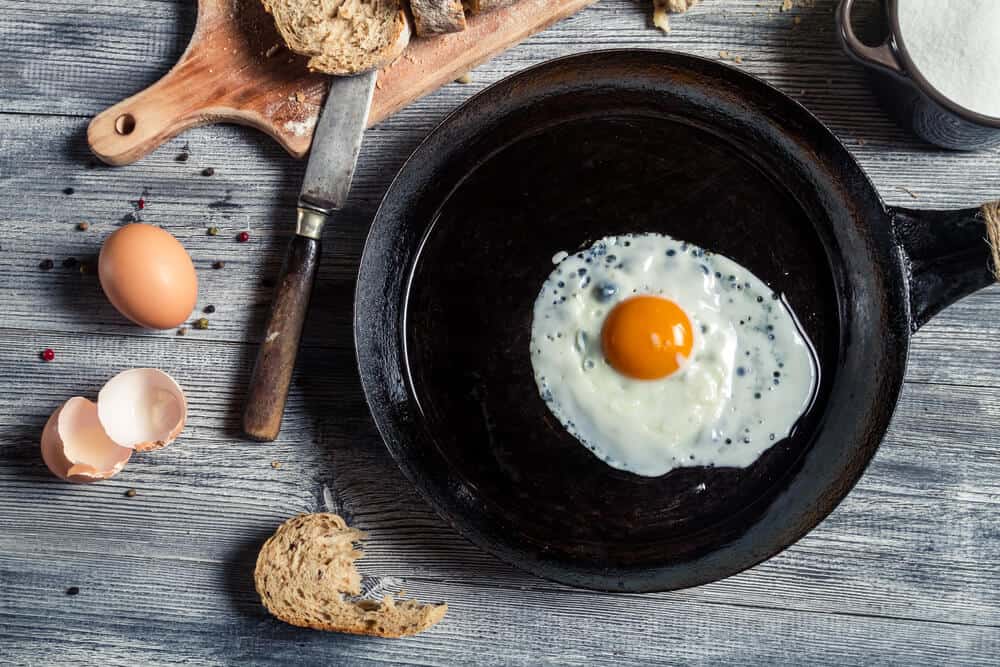No cast iron cooking site would be complete without addressing the #1 question about cooking with cast iron… How to season a cast iron skillet…
And while that question may seem simple, there’s more than one way to answer it. You can season your cast iron pan in the oven, on the stovetop, or simply by cooking the right foods in it.
The best method to season cast iron will depend on your situation. A newly restored cast iron pan will need a different seasoning method than a pan that already has a good base layer of seasoning. Here’s everything you need to know about how to properly care for and season your cast iron, no matter which method you choose:
How to Season Cast Iron in the Oven
Before you get started, remember that one of the benefits of cast iron is that it gets extremely hot, and it also holds heat very well. So be careful that you’re always using a hot pad when handling your cast iron skillet.
Step 1: Preheat your oven to 500 degrees.
Step 2. Preheat your cast iron on the stove on medium heat for about 5-8 min.
Heating your cast iron skillet on the stove first allows the pores in the metal to open so that the oil can soak in. Once the pan is too hot to touch, you’re ready to move on to the next step.
And remember, there is NO NEED to crank the heat up to high. Just keep your stove on medium and you’ll be fine.
Step 3: Add about 2 tablespoons of oil to your cast iron skillet, and spread it around with a paper towel.
Spread the oil completely around the skillet, inside and outside, using a paper towel… every nook and cranny, and don’t forget about the handle also. If you only use about 2 tablespoons, then you should be left with a nice thin coating of oil. If you have oil dripping off your pan or pooling up in the bottom of your skillet, then you will need to get a fresh paper towel to wipe the excess oil off.
You can keep your oiled paper towels to reuse the next time you season your cast iron pan. Eventually your paper towel will absorb enough oil that you won’t need to add oil to your skillet at all… you can just use the towel for a thin layer of oil instead.
I keep my oily paper towel right next to the stove with my frequently used cooking items like salt, pepper, and butter.
**Side Note – If you add too much oil and don’t wipe enough off, then you could be left with a sticky residue after your pan comes out of the oven. This residue is really difficult to remove, so it’s definitely best to make sure that you only add a THIN layer of oil to your cast iron pan.
Step 4: Put your cast iron skillet in the oven.
Once your oven is preheated, it’s time to transfer your skillet from the stovetop to the oven. (Remember to use your hot pad!) Place your cast iron skillet on the middle rack with it turned upside down. Then place either a sheet pan or a large sheet of aluminum foil on the second rack, directly underneath your pan, like this:

You should not have any excess oil to drip off (remember, you’re only using a THIN layer of oil), but the foil or sheet pan will act as a drip tray just in case.
Step 5: Bake your cast iron skillet for 1 hour.
After it has been baking for one hour, just turn off the oven and let your pan cool down inside the oven.
Step 6: Repeat steps 2 through 5.
After your cast iron skillet has cooled down in the oven, take it out and reheat it on the stovetop again. Apply another thin coat of oil, and bake for another hour at 500 degrees. Allow it to cool down and start again.
So, yes, you will need to be patient. This is a multi-step seasoning process which is important because it allows the seasoning to cure and develop that patina, or gloss. That’s what makes your cast iron skillet non-stick.
If you’re seasoning a cast iron skillet from bare metal (because you’ve just restored your rusty skillet) then you may need to repeat this whole process 3 to 4 times. However, if you’re just refreshing your coat of seasoning, then you will probably only need to do it once.
When to Season Your Cast Iron Skillet in the Oven
So since there are multiple ways to season a cast iron skillet, when do you want to use the oven method? You can season a cast iron skillet in the oven when:
- Your pan has no seasoning at all – This could be because you’ve just restored your rusty cast iron pan, or you’ve neglected it over time and it needs more love.
- Your skillet has burnt on food – If the seasoning on your cast iron skillet is starting to wear off, your food could start to stick. You may need to give your pan a good scrub down with soap and water, and then use the oven method to re-season your skillet.
- Your oven is already on – If I’m already cooking something in the oven, like a cake or a casserole, then many times I will go ahead and put my cast iron in the oven towards the end of that cook time (about 10 minutes left). Yes, you’re probably not baking a cake at 500 degrees, but you can still put a thin layer of oil on your skillet and bake it anyway. Then, when you take your cake/casserole/etc out of the oven, just crank if up to 500 degrees for the remainder of the hour.
- You need to RE-SEASON your pan – Over time the seasoning on your cast iron skillet wears off, so every now and then you will need to do the oven method to rebuild your seasoning.
Benefits of Seasoning Cast Iron in the Oven
There are a number of reasons why people choose to season their cast iron skillets in the oven versus on the stovetop. Here are some of the benefits of using the oven method to season your cast iron:
- To protect your stove – Since you should oil the entire pan (inside and outside) in the seasoning process, the oven method helps to eliminate the excess oil burning off on your stovetop. Imagine putting oil or fat directly on your burner… that’s essentially what you’re doing when you season your skillet on the stovetop.
- To evenly heat your cast iron – Most stovetops have “hot spots”, or areas of uneven heat. By baking your cast iron skillet in the oven, the heat evenly surrounds the pan and allows the seasoning to develop more evenly.
- To control the smoke – By putting your cast iron skillet in the oven and allowing the oil to burn off, you control the amount of smoke in your kitchen.
How to Season Cast Iron on the Stovetop
If you’re running short on time, or if your cast iron skillet is still nice and glassy, then you can get away with doing a quicker seasoning using your stovetop.
Here’s the quick way to season a cast iron skillet:
Step 1: Preheat cast iron skillet and add oil.
The oven and the stovetop methods start out the same way. Add about 2 tablespoons of oil to your preheated cast iron skillet, and wipe out any excess oil with a clean paper towel, if needed. Remember, there’s no need to heat your cast iron skillet on high heat… your medium stove setting should work just fine.

Step 2: Allow the oil to burn off.
Wait until the cast iron starts smoking and allow the smoke to calm down. It will smoke more at the beginning when you first add your oil, and as it burns the smoke will subside. After you notice the smoke has dropped to about 1/4 of what it was, just turn your burner off. Allow your pan to cool, and wipe it out again with that trusty paper towel you used initially.
If the oil is beading up, then this means your cast iron skillet is full and no additional seasoning is needed right now. Just wipe up the excess oil with a paper towel. Remember, the oil will be hot, so be careful.
Step 3: Repeat this process as needed.
During this stovetop seasoning process, the oil starts to smoke at its smoking point temperature. When heated, the metal pores of the pan open up and accept the oil, and when the oil burns off, it leaves a very thin layer behind. By repeating this process, you BUILD LAYERS of seasoning, which is the ultimate goal.
As you keep repeating the process, your skillet will smoke less and less because it will need less oil. Eventually your cast iron skillet will stop accepting oil, and you will have oil pooled in the bottom of your pan.
When to Season a Cast Iron Skillet on the Stovetop
Here are some common reasons to choose the stovetop method for seasoning cast iron:
- You only need to MAINTAIN your seasoning – If you already have a good layer of seasoning on your cast iron, then you can use the stovetop method for simple cast iron maintenance.
- You’ve just cooked something with a higher fat content – Cooking the right foods in your skillet will naturally help your seasoning. If I’ve just cooked bacon or burgers, I skip the oven method and just season my skillet on the stovetop.
- You’re running short on time – Obviously, the stovetop method of seasoning is much faster than the oven method, so if time is an issue, then the stove is better than nothing.
How to Season a Cast Iron Skillet by Cooking with It
One thing you can do to speed up the seasoning process is to be very selective about the food that goes in to your cast iron for the first few cooks. It’s like killing two birds with one stone. You can cook a great meal, and work on building the seasoning on your pan at the same time.
Here are some great foods to cook to help build the seasoning in your cast iron pan:
- ground beef
- steak – Check out this post on How to Cook Filet in a Cast Iron Skillet

- sausage
- bacon
- sautéed vegetables
- hamburgers
- chicken
- fried anything – fried fish, country fried steak, etc.
- grilled cheese
- quesadillas
Sautéing veggies in avocado oil is great for your pan. Browning any meat is great. Deep frying is great. Any time you can cook with a larger amount of fat and a higher than normal temp, you are going to help really speed up the seasoning process.
You should AVOID ACIDIC FOODS when trying to build seasoning. The acid from foods like tomato sauces, vinegar-based recipes, and wine will eat away at the seasoning that you’ve been working so hard to develop.
FAQ’s about Seasoning a Cast Iron Skillet
What oil should I use to season my cast iron pans?
When seasoning cast iron, you need to choose an oil with a high smoke point. Why? Because a higher smoke point oil allows the cast iron to get hotter, which in turn burns the oil into the cast iron, creating a non-stick surface after multiple applications. .
Crisco and avocado oil are my go-to oils when either seasoning or re-seasoning my cast iron collection. The avocado oil I use has a burn temp of 500 degrees, plus it’s neutral in flavor and on the cheaper side compared to other specialty oils.
Why is my cast iron skillet brown?
Newly seasoned cast iron will have a brownish tint to it. Don’t worry… it’s not rust. It’s just the initial step of slowly burning that high heat oil into your cast iron. Your cast iron will change from a gray color to light gold to light brown to dark gold to dark brown and, finally, to black. That’s when you know you have created that patina that makes your cast iron non-stick.
Can I really use paper towels to season a cast iron skillet? I heard that was bad to do.
Paper towels are actually my go-to tool to season cast iron, mainly because they’re cheap and disposable. Now, I will say that not all paper towels are created equally. I’ve found that certain brands will leave lint behind in the pan. My favorite paper towels are the Kirkland brand paper towels from Costco.
If you notice your paper towel is leaving a lot of lint behind, you’ll want to try a different brand. You can also use shop towels or bandanas.
How many times do I need to repeat the seasoning process?
This all depends on a variety of factors… what did you just cook, is this a newly restored pan, etc.
Normally, I will just go through my seasoning process once. But, for instance, when I recently restored a rusty Griswold cast iron skillet, I went through the seasoning process four times because I had completely removed all of the seasoning in the restoration process.
Do I need to re-season my cast iron after every cook?
Once your cast iron is properly seasoned, do NOT assume it will stay seasoned. You will need to maintain the seasoning by using either the stovetop or oven method, depending on the condition of your pan and what you have just cooked.
What’s with the “egg test”?
If you watch people (including me!) test the seasoning on their cast iron skillets by cooking an egg, you may be wondering if we all own stock in chicken farms. The answer is no.

So many people decide to cook an over easy egg in their newly seasoned cast iron skillets because an egg will stick to anything if it’s not seasoned properly. Cooking an egg is a good gauge on how far you have come and how far you need to go. Plus, eggs are cheap!
If the egg sticks in your pan, then just over-cook your egg and scrape it out with something like a square-headed wooden spoon. Avoid using a sharp-edged metal utensil because it could damage your new seasoning. You can also add just a touch of hot water to the pan, and the steam will help release the eggs. DO NOT add cold water to a hot cast iron pan!
Just clean out the stuck-on egg, reheat your pan, and add more fat. When I’m cooking eggs in the morning, my go-to is a swoosh around the pan of avocado oil and about 1/2 tablespoon of butter for 2-3 eggs.
*Side note – Just make sure your cast iron is preheated enough before you add the eggs. If not, your eggs will stick, which is not necessarily a reflection of your seasoning process.
Have you tried any products that were specifically designed for seasoning cast iron?
Yes! (I’m glad you asked!). I recently tried the Crisbee puck. It did work, but I couldn’t tell any difference in that versus good ‘ol Crisco. And since Crisco is cheaper, I’ll just stick with that.
And that’s how to season a cast iron skillet in a not-so-small nutshell…
As you can see, there is more than one “right” way to season your cast iron. The method that you choose will depend on the condition of your pan (and probably your level of patience also!).
If you have any questions about cooking with cast iron, feel free to leave a comment down below!







Comments & Reviews
Nicole says
This is a great article and helpful to people like me who are new to cast iron and learning to season cast iron properly, thank you for posting it. I am struggling to understand how to properly clean the cast iron after cooking in it without damaging the seasoning I went through the process of building. Any tips or recommendations would be appreciated. Thank you!
Jaqueline Kyoda says
Also how to do you reccoment getting burnt food off the bottom? It’s obviously past the time to season it, but needing to figure that out before seasoning it…thankyou!
Jaqueline Kyoda says
HI, really appreciate how thorough your blog is on the cast iron. I’m needing to reseason one that is flaking. There’s a darker layer of black that is chipping off and below is more iron. Is it time for the pan to go or is it salvegable. I don’t think it’s ever been seasoned.
Bill Hanggi says
Thank you for helping to educate us all.
Since you are clearly a fan of avocado oil for seasoning, are you assuming a person is using avocado oil when you specify a 500° oven temperature? Would the temp be different for other oils?
Nicole says
Every type of oil has its own smoke point, there is even a difference between refined oils and unrefined of the same type. So, for example avocado oil that has been refined would have a higher smoke point than unrefined, and some are a blend of the two types. If the smoke point or temperature tolerance isn’t mentioned on the bottle somewhere, calling the company would be my go-to. Not all info online is accurate so best to get it from the horse’s mouth.
cliff brown says
Tried many oils and yes grapeseed and avocado are my best. About the paper towls..I use the blue paper towls..no lent
Jason says
Please educate me as I am very confused about something.
I need to season a cast iron skillet and I watched some how-to videos (before reading this site’s fantastic instructions) that stated that when doin the stove top method you should never allow it to get hot enough to smoke as it will burn off the oil u add (always medium heat).
Now, the reason I am confused is I recently successfully seasoned a BS outdoor griddle per the manufacturer’s website and it stated to let the oil get hot enough to smoke and leave on until it stops smoking because this burns off the organics and leaves a polymer. It worked and made the griddle darker as described..
My question (confusion) is why would I want smoke when seasoning the griddle but not want a cast iron skillet that I am seasoning on the stove top to do the same thing? Is it because theres a difference in metal or was the how-to videos wrong when stating to NOT get it hot enough to smoke?
Jason says
Best seasoning instructional I’ve ever read. I’m a long time cast iron user but just used refined avocado oil for the first time on a newer pan that needed some additional seasoning and I was blown away! Best seasoning oil I’ve ever used! It’s almost like baking a layer of porcelain onto your cast iron! It will be my go-to oil from here on out!
Neal says
Glad to hear you liked the post! Yes, avocado oil has pretty much been my go-to seasoning oil for a long time now, for everything from my cast iron pans to my outdoor griddles. Thanks so much for the comment!